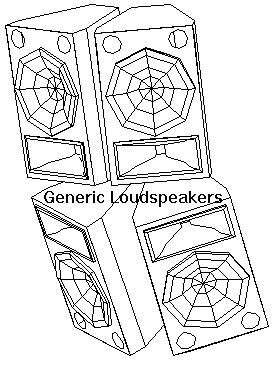
Main Page |
A guided tour of a loudspeaker clusterSometimes it is hard to tell just what we are referring to when we talk about problems with these small box clusters, so we've added an image map to allow you to get some "hands on" experience with this cluster. If your browser supports image maps than you can move your mouse over this cluster and click on the image you will pop down the page for a more thorough explanation of each element we are discussing.  for Speech Intelligibility Page The WooferThe 12" woofer in these small boxes (and even 15" woofers) exhibit a wide variation in their coverage angle. At frequencies below 500Hz the coverage angle expands beyond hemi-spherical and will become omnidirectional at 100Hz. Above 500Hz, up to the crossover frequency, the coverage pattern will narrow, but will not drop much below 120 degree conical coverage. Both 12" and 15" woofers will reach a point where the coverage narrows drastically (called waistbanding), dropping below 60-70 degrees. This frequency will vary but is typically just below the crossover point on these small boxes, in the 1000-1500Hz range. This sucks the mid out of the off-axis response, and boosts it on-axis. If this bump is equalized out on-axis there will be an even bigger drop in off-axis response at these frequencies.
The HF horn has to have a small mouth to fit in these small boxes. This results in the vertical coverage varying with frequency. At 1500Hz, the vertical coverage may exceed 100 degrees, and above 2500Hz the coverage will meet the typical specified coverage of 40 degrees. This will cause variations in vertical off-axis response of a single box. You can notice this easily if you turn one sideways and listen to it as you walk across the vertical coverage pattern. This will cause problems as you put several horns together.
The wide coverage of the woofers ensures that in this cluster configuration sound from all four woofers will reach any listening position, all with some small time delay, except for one spot exactly on axis with all four woofers. This is where the huge variations come from in the measurements we made of this cluster. Right down the middle they all add up, everywhere else, and especially underneath these boxes, the low frequency response will change with every listening position. This will affect the feedback threshold in the low frequencies, where most microphones lose their directional characteristic.
Because of the wide vertical coverage variations of a single horn, there will be significant vertical overlap in the 1500Hz to 2000Hz region. This will result in lobes in the vertical coverage, and big variations in the sound character with various seating positions. There is some overlap in adjacent horns in the horizontal plane as well.
Often these systems have horns with wide horizontal coverage, in the order of 70-90 degrees, which will result in the coverage overlapping in the horizontal plane when the boxes are arrayed with the sides touching. These small horns also have some problems keeping the horizontal coverage under tight control near the crossover frequency. This means that in this cluster configuration, all four horns can be interacting near the crossover point and all four can be be audible at any listening position. This produces even more lobes in the coverage, and even more variations in the response between 1500-2500Hz in the listening area. |
